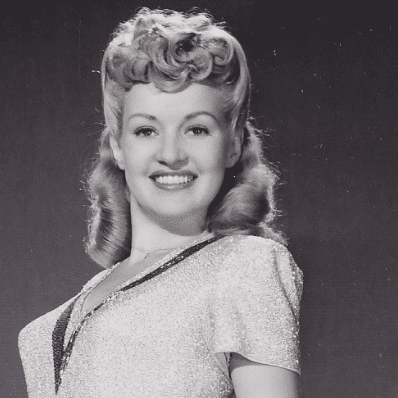Betty Grable, wartime pinup queen and the stunning “girl with the million dollar legs”, was a Hollywood sweetheart that will forever hold a spot in our hearts, in countless classic films, and at the Golden Steer Steakhouse.
What set her apart from many others in Hollywood was that unlike many Hollywood stars of the time, her life was devoid of scandal and she was especially active in aiding her community. She contributed to raising money and visiting sick soldiers in World War II, focusing more on her family and servicemen than being a star, even though at one point she was the highest paid star in Hollywood.
An American actress and dancer, this beauty starred primarily in musicals. Her wholesome and good-natured personality was shown off on the screen, and she did many athletic dance numbers in which her shapely legs became the most famous legs in America. Gable rose to stardom and was one of the top box office draws in the 1940s.
Betty’s Rise to Fame:
Betty was born as Ruth Elizabeth Grable on December 18, 1916, in Saint Louis, Missouri as the daughter of a stockbroker. Grable’s mother first set her on the path to stardom and was determined to make her daughter a star when she enrolled her in dancing school at the young age of three. Grable then began her studies of ballet and tap dancing, as well as music classes.
In 1929, Grable first landed parts in Hollywood musicals at only 13 years old, when her mother lied about her age to land her small chorus girl parts in several musicals, such as Whoopee! (1930), New Movietone Follies of 1930 (1930), Happy Days (1929), and Let’s Go Places (1930).
In 1932, Grable signed with RKO Radio Pictures when she was 15, and she continued to be in small parts for the next three years until she finally got a bigger role in By Your Leave (1934) and in College Swing (1938). Although the rising star, who sometimes used the name Frances Dean, began to land bigger parts, the public was not taking particular interest in her quite yet.
It wasn’t until 1939 that she made an impression and caught the eye of many on Broadway in Cole Porter’s musical Du Barry Was a Lady. After that, 20th Century Fox called her to Hollywood, and her first blockbuster hit in 1940 when she starred in Down Argentine Way. This was the same year that she divorced her first husband, the former childhood star Jackie Coogan, whose success had contributed to her rising Hollywood film career.
As the star’s fame shot upwards, her films, such as Moon over Miami (1941), Sweet Rosie O’Grady (1943), Pin Up Girl (1944), and The Dolly Sisters (19460).
At the height of her fame, she became the highest-paid star in Hollywood and the highest-paid woman in the United States - earning about $300,000 a year a phenomenal sum at the time. The actress was ranked in the 10 top box office stars for 10 years in a row (1942-1951), held the number one spot in 1943, and was the highest-ranked woman for 7 other years.
As her films contributed to pulling 20th Century Fox, who she was under contract with, out of debt, it’s no wonder that they insured her legendary legs - for a million dollars!
Grable absolutely enchanted the public and also became the wartime pinup queen. She provided not only entertainment, but a much-needed escape as well. During World War II, American servicemen voted for her as their favorite pinup girl.
Bomber planes and barracks were even adorned on their sides with her breathtaking image - the pinup photo of a leggy blonde in a bathing-suit, glancing over her shoulder towards the camera with a playful smile on her face and her hands on her hips. She reminded soldiers of “the girl back home” when they were homesick and needed to remember what they were fighting for.
Grable also aided in the raising of millions of dollars by participating in many war bond rallies. She performed at the Hollywood Canteen when it opened on October 3, 1942 for young soldiers before they headed off to war and then danced with them afterwards. Frank Powolney took the famous pinup photo of her that was sent off to war with all of the servicemen and estimated to have been copied about five million times. She was the first and most popular pin-up model of World War II.
Grable continued contributing to wartime efforts by participating in a war bond drive throughout the western states before starting Coney Island (1943). She would also visit wounded soldiers in hospitals, and she sold a pair of nylon stockings that she had worn for $110,000 and gave the proceeds to a nationwide bond drive for the war.
Her movie career began its decline in the mid-1950s simultaneously with the decline in the popularity of musicals. Musicals were declining, and television was rising. Ironically, as the popularity of her films went down, her last film was How to Be Very, Very Popular (1955).
She then focused on nightclubs and Broadway, sometimes joining her second husband the bandleader Harry James, who she was married to until 1965. Hello Dolly was her most notable Broadway musical (1967).
She continued entertaining until she passed away at age 56 from lung cancer on July, 2 1973 in Santa Monica, California.
How We Remember Her at the Steer:
Betty Grable will always hold a place in our hearts, and her memory will always be honored at the Steer.
We continue to honor the woman that she was - a woman who took the world’s breath away, and at the same time breathed life into all who encountered her.
Booth #1 will always remain dedicated to Grable, a loyal patron of the Steer.
